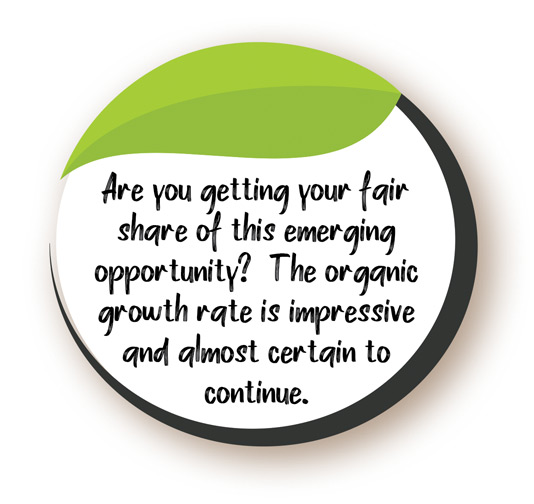
It’s no secret that organic produce is popular with a growing segment of consumers. Pick up any consumer preference survey and you’ll see broad interest among consumers in seeing more organic products in their supermarket. However, high prices and limited availability have made it challenging for retailers to expand their organic assortment.
To get a deeper understanding of the organic produce trends in supermarkets, we looked at four years of Nielsen scan data for produce. This broad database covers performance for over 18,000 U.S. supermarkets, so it provides a solid barometer of the national produce trends. Based on the data, here are three reasons you should look long and hard at increasing the organic produce in your stores.

- Organics are driving produce growth—in fact, organics are delivering the ONLY produce department growth. If you look at the Nielsen data for total produce sales nationally between 2015 and 2018, you see a somewhat shocking storyline. Over this four-year period, conventional produce showed a disappointing 2 percent gain in sales (well below the rate of inflation), while total conventional produce volume declined by 1 percent. During the same period, organic produce sales grew by 28 percent and volume jumped 29 percent. The stark reality over the last four years is organics have been the only broad driver of growth in the produce department. Stores that underplay organics miss out on the single biggest opportunity to boost dollars and volume in the produce department.

2. Organic production and assortment are increasing. High Free on Board prices have encouraged organic investment and field conversion by growers. This trend is obviously revealing itself in the strong increases in volume, but assortment is expanding across mainstream categories (packaged salads, berries, apples, etc.) as well and exploding in categories that have traditionally had limited organic options. For example, the four-year Nielsen data reveals a 131 percent increase in organic blueberry sales, an 88 percent jump in sales of organic mushrooms and a 51 percent jump in organic bananas. In some of the smaller categories, organic Brussel sprouts are up 265 percent, organic kiwi sales are up 246 percent and organic sweet corn is up 219 percent. Every store has more organic products available than ever before to entice the shopper. It’s also important to remember that with higher price points on organics, every conversion by a shopper from a conventional item to the substitute organic item increases dollar performance for the retailer even when volume is unchanged.
3. There is well defined roadmap for enhancing organic performance. While organics are growing, the national Nielsen data reveals that retailers should focus first on the select, high-volume organic categories most likely to drive consumer purchases to build a foundation for successful sales (and reduced shrink). Case in point, the top five organic categories drive 57 percent of U.S. sales. So where to start? The data is clear, organic success starts with packaged salads and berries. Nationally 21 percent of all organic sales dollars were packaged salads. The single biggest category opportunity for retailers is spending the time to get the organic assortment, pricing and placement correct on organic packaged salads. The next key category is berries which drove 17 percent of organic sales. From 2015-18, 28 percent of total organic dollar growth was driven by the berry category. With 38 percent of total organic dollars coming from packaged salads and berries, it’s obvious why supermarkets must focus here first when building an organic sales plan. Rounding out the top 5 organic produce categories are apples (7 percent), carrots (6 percent) and potatoes (6 percent). What else? We can’t overlook organic bananas. Because the price point is comparatively low on organic bananas, this category only contributes about 5-6 percent of organic dollars. But the volume opportunity is huge. Nationally, organic bananas are the runaway no. 1 volume leader, driving a stunning 22 percent of total organic volume.
JUST ASK: Ask your District Sales Manager for a list of organic produce items available in your division







